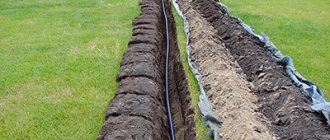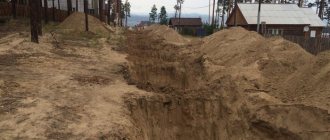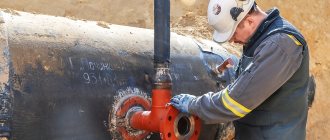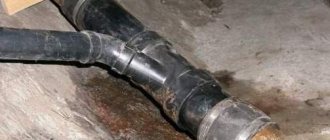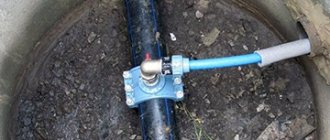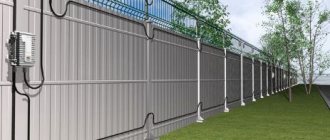Tapping into an existing gas pipeline under pressure is carried out by professional craftsmen or independently in compliance with all requirements ensuring the maximum level of safety. After doing the work yourself, it is necessary to attract specialists who can check the correctness of the work and issue permission to put a private gas pipeline into operation. Read more about how to do the work below.
Connecting a private gas pipeline to a centralized system
What is tapping into a gas pipeline under pressure?
An insertion is the connection of a pipe to a gas pipeline under pressure.
Technologies make it possible to make connections even into main gas pipelines without stopping gas pumping. Conditions for tapping into a gas pipeline:
- the operating gas pressure in the pipe should be 20–80 mm. water Art.;
- tapping into a high-pressure pipe can only be done after the pressure has decreased to the permissible level;
- if it is impossible to reduce the pressure, you need to use special equipment;
- without reducing the pressure, tapping into pipelines is carried out only by organizations with special permits;
- gas welding and metal cutting can be carried out during tapping at a gas pressure in the pipe of 40-150 kg/cm2.
An insertion into a gas pipe can be:
- Cold. The pipeline with such an insertion operates in normal mode, i.e. the volume and pressure of gas do not change. The technology is usually used to connect new users to main gas pipelines.
- Welded. Traditional welding on gas pipelines under pressure. This type of work requires high qualifications and special permission.
Security
The next stage is carried out by an invited team. Before connecting to the gas pipeline, you need to:
- draw up a diagram of connection angles;
- choose the insertion method, calculate the order and method of reducing pressure, determine ways to maintain the indicator at the desired level;
- calculate and select the required amount of materials, tools, rescue and protective equipment;
- close the taps, valves, plugs on the connected pipe;
- stock up on the required amount of water to prevent fire or fire.
Before insertion, control testing of pipes, connected system and air outlets is carried out.
How to tap into plastic gas pipelines under pressure
For such inserts, factory-produced shaped parts and fittings are used. As a rule, metal fittings with a socket connection are used, which are glued after installation with special adhesive compositions. The adhesive seam must be sealed, and the steel insert must be treated against corrosion. The insertion is made with steel inserts located perpendicular to the gas pipeline. The length of the metal insert is 70-100 cm. It is heated to 60 degrees and a plastic pipe is placed on it. The method is used for tapping into high and medium pressure pipes.
What influences the preparation of the project
If special skills are lacking, independent design is undesirable and unlikely to be feasible. In the process of working on a project, many factors that are known only to specialists must be taken into account.
Among them are:
- depth of groundwater, soil specifics, landscape and climatic features;
- the depth at which the central route runs;
- distance from the pipeline to the building, taking into account the depth of the outlet;
- SNiP requirements for equipment and connection points.
In addition to what is listed in the project, the method of laying the pipeline, the diameter of the gas pipeline, the required set of instruments and fittings, the materials used, the features of the joints and internal wiring must be shown.
How does tapping into steel gas pipelines take place under pressure?
Steel gas pipelines remain the most common, and insert welding is the main type of connection. Of all the types, T-bar insertion into the gas pipeline is most often used. Without reducing the pressure in the gas pipe, the insertion is made through a valve or using a special PGVM device. The first method is inconvenient, in particular, due to the need to construct wells. The PGVM device in the walls of pipes with diameters from 186 to 529 mm allows you to cut holes of 80 and 140 mm, making taps through a pre-welded pipe. The method using PGVM is more technologically advanced, convenient and reliable.
What are the types of gas transmission lines?
A gas pipeline is a specialized pipeline whose purpose is to transport and store certain volumes of blue fuel. It may have different design features, differing depending on the tasks assigned to the highway.
For example, networks of international importance deliver huge volumes of gas over long distances, so they maintain constant pressure at a high level. That is why any experiments with gas supply systems are inappropriate and can be dangerous not only for you, but also for others.
This means that the best option for working with the system would be to call the appropriate services specializing in working with gas communications, which meets the requirements of the law.
Gas pipelines are designed like the circulatory system of the human body. Their role can be compared to the coronary vessels. And from the central pipes, regional pipes depart, distributing blue fuel among consumers.
They are smaller than the main ones, and therefore the pressure in them is much lower. However, even in such gas networks, its jumps are possible both in a decreasing and in an increasing direction.
Connection to gas communications occurs if the organization has a special permit. And you can try to do the wiring inside your home yourself. To do this, you just need to know a clear sequence of actions and adhere to the necessary safety measures.
Liability for illegal tapping into a gas pipeline
Despite the serious statistics of penalties for unauthorized tapping into gas pipelines, the number of cases of this type of violation is not decreasing. The punishment for this offense depends on various circumstances that are taken into account when investigating each individual case. For example, if a violation is detected immediately after an illegal tapping into a pipe, administrative penalties may be applied to violators under Art. 7.19 Code of Administrative Offenses of the Russian Federation. In this case, violators will face an administrative fine in the amount of 1,000 to 3,500 rubles. In this case, the violator must repay the debt to the gas supplier and reimburse the costs of restoring pipelines and other equipment.
If there were repeated tappings into gas pipelines, the violator evaded payment for the selected gas, his actions are regarded as a crime in accordance with paragraph “b” of Part 3 of Art. 158 of the Criminal Code of the Russian Federation “Theft in open access.” This article provides for a fine of 100 to 500 thousand rubles or imprisonment for a term of 2 to 6 years.
Authorized organizations
In each city there are a number of organizations that provide their services in the field of designing dangerous devices. Such objects include not only gas pipelines, but also other elements of gas consuming networks and boiler houses. As a rule, after their creation, all design organizations are required to become members of self-regulatory organizations (SROs). Otherwise, the company will not be able to participate in tenders and receive serious orders.
The presence of an organization in the SRO structure guarantees customers safe and competent performance of work. In case of failure to fulfill the terms of the contract or poor quality of services, a design company that has an SRO certificate risks not only its reputation, but also its financial resources.
SRO certificate. (Click to enlarge) Membership in the SRO can only be obtained by those companies that permanently employ at least two gas supply system design engineers.
The qualifications and knowledge of these specialists are checked every three years by a special commission. After successfully passing the exam, engineers receive certificates.
Contrary to popular belief, an organization does not have to have a license. Licensing of project activities was cancelled.
Be careful: before ordering a gas supply project from the selected company, you need to inquire about the availability of an SRO certificate and full-time specialists in gas systems.
When concluding a contract, it is important to clarify that the contractor assumes the responsibilities for measurements, visits to the gas service, coordination and approval of the project. This clause will allow the customer to relieve himself of responsibility for the design process and results.
This article is about how to properly install and connect a gas boiler. Read the article about the required list of documents for gasification of a private home here.
Process description
Naturally, the work begins with the preparatory stage, regardless of whether you will cut into the system yourself or choose a specialized service. If the latter, then you need to contact the appropriate authority, fill out an application, and possibly provide the package of documents required by law. Have you decided to connect a new pipe yourself? This means that you need to buy the appropriate materials, prepare the system and yourself for the planned work. So, if the preparatory stage is completed successfully, we begin the insertion.
Connection of metal systems
- Surface cleaning. Remove paint, debris, and rust from the place where you plan to make the insert.
- Marking. Determine where the connection will be and mark it.
- Making holes (with the coil method - 1, with the T-bar method - 2).
- Well treatment. The cracks should be treated with clay, and it is recommended to begin this process while cutting the surface in order to minimize the risk of burning/ignition of leaked blue fuel. The finished holes must be closed as quickly as possible with a special plug (made of asbestos and clay). The treated area must be cooled.
- Installation of disconnecting device. When the metal has cooled, the plug can be opened to remove a fragment of the cut pipe from the structure. After removing the piece of metal, a disconnecting device is placed in the gap, which is a set of disks made of wood and rubber, as well as a bag of viscous clay. If you adhere to the T-bar method, then there will be two such slots.
- Installation of the pipe. When the disconnecting device has covered the gap, it’s time to start making the main hole - for the attached (new pipe). Check that the diameter is correct; it is possible that the markings will have to be corrected. Make a hole and install a pipe. Weld the joints of the pipe on both sides, then close the valve on it.
- Sealing the hole. So, the pipe is welded, now we need to weld a new pipe. To do this, first remove the remaining metal that appeared as a result of making the main gap. Insert them into place, treat them with clay, and brew them too. Check if the weld seam is leaking gas (using soap).
- Connecting a new pipe.
Rules for calculating throughput
The main factor responsible for the continuous supply of blue fuel to consumers is the throughput capacity of the gas pipeline. This parameter is calculated using a special algorithm. Moreover, it is done regardless of the type of pipes used.
The maximum throughput of a gas pipe can be calculated using the following formula:
Q max. =196.386×D²×P/Z×T,
- P – operating pressure maintained in the gas pipeline, plus 0.1 MPa or absolute gas pressure;
- D – internal diameter of the pipe;
- T is the temperature of the pumped blue fuel, measured on the Kelvin scale;
- Z – compressibility coefficient.
This formula establishes the following pattern: the higher the value of the T indicator, the greater the network throughput should be.
Otherwise, the gas transmission line will depressurize, which will inevitably lead to an explosion of this dangerous substance.
There is a more complicated formula. However, the algorithm given above is quite sufficient to perform the necessary calculations prior to inserting into the gas pipeline.
What are the types of gas transmission lines?
A gas pipeline is a specialized pipeline whose purpose is to transport and store certain volumes of blue fuel. It may have different design features, differing depending on the tasks assigned to the highway.
For example, networks of international importance deliver huge volumes of gas over long distances, so they maintain constant pressure at a high level. That is why any experiments with gas supply systems are inappropriate and can be dangerous not only for you, but also for others.
This means that the best option for working with the system would be to call the appropriate services specializing in working with gas communications, which meets the requirements of the law.
Gas pipelines are designed like the circulatory system of the human body. Their role can be compared to the coronary vessels. And from the central pipes, regional pipes depart, distributing blue fuel among consumers.
They are smaller than the main ones, and therefore the pressure in them is much lower. However, even in such gas networks, its jumps are possible both in a decreasing and in an increasing direction.
Connection to gas communications occurs if the organization has a special permit. And you can try to do the wiring inside your home yourself. To do this, you just need to know a clear sequence of actions and adhere to the necessary safety measures.
General requirements for gasification
Gas heating is a service with a high level of potential danger. For this reason, there is a whole set of requirements that must be met regardless of the material used and the chosen method of laying the system.
The basic rules include the following:
- Possibility of constant and free access to all connecting elements of the gas pipeline system; such nodes cannot be walled up in walls.
- No contact with flammable elements of the building, which include door frames, window frames, partitions made of flammable materials, and other similar structures.
- Wiring without bevels inside and outside the house. Strictly vertical installation is mandatory, and in the horizontal version, a slope of 2 to 5 mm is allowed with a distance of a meter to the instrument devices.
- Placement of the riser outside habitable premises. If there is no suitable interior space, it can be installed from the outside along the facade; the permissible slope cannot exceed 2 mm.
When designing the installation, it is recommended to pay particular attention to the installation of taps. Their center line in any case should be parallel to the wall.
When installing equipment, be sure to check the correct location of the gas taps relative to the wall
Without compliance with these and other requirements of SNiPs, the gas pipeline will not be put into operation. Additional costs for eliminating such violations are the least of the troubles. Putting into operation with such deficiencies can lead to more serious consequences.
Joining of profile pipes
The most affordable way to connect profile pipes is by installing fastening clamps. Using these simple devices, it is convenient to assemble any type of small-sized metal structures, erecting canopies and shelving, greenhouses and fences, canopies and modular partitions.
The undeniable advantage of using fasteners is ease of installation and the ability to disassemble the assembled structure an unlimited number of times.
To implement this method you will need only three components:
- Rolled pipes cut to size.
- Required number of fastening clamps.
- Wrench.
Crab clamps can be “X”, “G” and “T”-shaped elements, with the help of which it is convenient to join straight sections of pipes, corner structures and simultaneously connect up to four segments within one unit.
When assembled, they have the shape of a square or rectangle, the sides of which tightly fit the joined parts of the metal pipes.
Fastening with crabs should not cause any particular difficulties. Anyone can insert the cut pipes into the clamp and secure the clamping sticks by tightening the bolts on the system.
But this method can only be used for profile pipes with a cross-section of no more than 20 x 20 mm, 20 x 40 mm and 40 x 40 mm. In addition, joining of elements can only be done at right angles.
You can connect square pipes without welding by installing fittings of a given profile.
There are several types of fasteners in the form of fittings:
- Couplings - at joints on straight sections.
- Crosses and tees - for installation in branching areas;
- Elbows and turns – if it is necessary to change the direction of the pipeline.
With the help of fittings, you can obtain a fixed fastener, the only vulnerable point of which is the susceptibility to corrosion, which is typical for the ends of the joined elements inserted into it.
This situation occurs as a result of the accumulation of condensate inside the fastener. It will cause rusting if the metal pipes are not treated with an anti-corrosion compound.
Construction of a well for the construction of a site
To simplify the installation into an existing water supply system, it is convenient to use an inspection well. The diameter of the structure should be about 70 cm. This space is enough to place shut-off fittings (in the form of a valve or gate valve), as well as perform all the necessary manipulations for insertion.
In the future, during the period of operation, the presence of such a structure will facilitate the work of repairing the home water supply system.
The water pipe tie-in unit, used to disconnect the input for the period of repair work, will be placed immediately inside the shaft near the connection point with the external water pipeline
To construct a well, a new pit of the appropriate size is dug. The bottom of the pit is covered with a gravel “pillow”, forming a layer 10 cm high.
To make a reliable foundation, sections of roofing material are spread over the leveled gravel fill and a concrete screed 10 cm thick is poured. When creating the fill, concrete grades M150 and M200 are used.
After three to four weeks, when the concrete has acquired the necessary strength, a shaft is erected above the slab. To do this, the walls of the pit are lined with bricks, cement blocks or reinforced concrete rings. The neck of the structure must reach zero level.
If the well is to be installed in an area where the groundwater level rises to one meter during the flood period, it is necessary to construct a waterproof structure.
It is most convenient to purchase a ready-made plastic container for this purpose. From below it is anchored to a concrete slab, from above this structure is covered with a cast slab equipped with a hole for installing a hatch.
My method of insertion - instructions from the master
As in any business, connection to a gas pipeline must be carried out from the preparatory stage. If you prefer to connect the new pipe yourself, then you need to purchase the necessary materials and get to work:
- Cleaning the work surface from debris and paint.
- Make markings where you plan to make connections and holes.
- Treatment. This applies to wells, the cracks of which should be coated with clay to avoid the danger of burning or ignition.
After this, you need to make a plug by mixing clay and asbestos, and close all the processed holes and cool them.
- Installation. After cooling, remove the plug and remove part of the cut pipe from the structure. Next, we place wooden and rubber disks into the hole, which are called a disconnecting device.
- Installation of the pipe. After closing the gap with the disconnect device, it is time to create the main hole for the new pipe. We complete it and install the pipe, weld the joints on both sides and close the valve.
- Closing the hole. All excess metal should be removed and inserted into its place, which should then be treated with clay and welded.
- Joining. The gap must be checked to see if it allows gas to pass through (using soap). If not, then feel free to install a new pipe and you’re done.
Distance from the house to the object outside the fence
When deciding on the placement of a house on a site, they also take into account the distance of the future building to power lines, gas pipelines, railways and cemeteries. This will protect households from traffic noise and fumes from burial sites, and avoid flooding and subsidence of a private building located on excessively wet soil.
Before power lines
To protect the population from electric shock due to accidental deformation of wires, security zones are established on both sides of power lines. Within these areas, housing construction and the construction of dacha and gardening partnerships are prohibited. If a house does end up within the power line, it is not demolished, but a ban on reconstruction and capital construction is imposed.
The minimum distance from the house to the power line depends on its voltage
Compliance with power line security zones also ensures the safety of the electrical network section from fluctuations that occur during the construction of a house. The safe distance from the fence to power lines is determined based on the voltage level and is:
- 35 kV – 15 m;
- 110 kV – 20 m;
- 220 kV – 25 m;
- 500 kV – 30 m;
- 750 kV – 40 m;
- 1150 kV – 55 m.
To the pond
When dreaming of a house near a river or pond, you need to determine whether the purchased plot is included in a water protection zone - land adjacent to a water body with special legal protection. The establishment of a special regime is aimed at preventing pollution, siltation and salinization of the soil, preserving the richness of waters and maintaining the natural biocenosis.
The minimum distance from the house to the river depends on the type of reservoir
Building a house near a pond also carries the risk of its destruction due to its placement on softened soil. When laying the foundation, the width of the water protection zone of a river or sea is taken into account. This territory is determined by the length of the reservoir and is:
- 10 km – 50 m;
- up to 50 km – 100 m;
- over 50 km – 200 m;
- for the sea - more than 500 m.
To the gas pipe
If there is an external gas pipeline on the site, the distance between it and the house must be at least 2 m. The safety distance for underground pipes is determined based on the gas supply pressure. Within populated areas, as a rule, the pressure in the gas pipeline does not exceed 0.005 MPa. In this case, the foundation is laid at a distance no closer than 2 m from the gas pipe.
In the village, a distance of 2 m is sufficient to the low-pressure gas pipe
To the road
In different settlements, the distance between the fence and the road varies. In small villages, as a rule, this figure should be at least 3 m. If the local administration has allowed to deviate from the standards, it is still better to build a fence away from the passage. This will not only protect residents, but also make it easier to access the site.
It is better to stay away from the dust and smells of the road: at least five meters from the fence
When talking about the distance between the fence and the road, the concepts of “road” and “roadway” are distinguished. The first is called a roadbed with a pedestrian zone and a roadside, the optimal distance to which is about 3 m. The second is considered an area for the movement of vehicles. If the land plot is located near highways, the distance to the fence should be at least 5 m.
To the cemetery
The norm for the distance from a cemetery with an area of more than 20 hectares to a residential building is at least 500 m. If the site is located in a village near a small cemetery, the dwelling should be located at least 300 m away from it. For columbariums, memorial complexes, closed burial places, the permissible the distance to the home is 50 m.
The minimum distance to the cemetery is determined by its size
To the railway
The noise and smell from the railway will not please anyone: we are building a house no closer than 100 m
To protect land owners from train noise, the distance from the private sector to the railway must exceed 100 m. If the railway track is located in a depression, or the carrier company has taken measures to ensure noise protection (installed noise barriers, fences), it is permissible to build a house near the tracks, but not closer than 50 m.
We hope that the recommendations outlined will help you make the right choice of placing a house on your own site. In any case, it is better to make sure it is correct by discussing your plans with the local administration and neighbors. Author of the text: Miroshnikov A.P.
